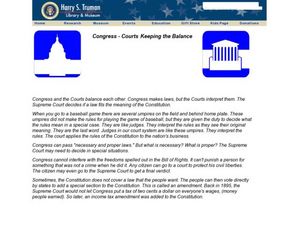Curated OER
Separation of Powers: Connecting the Separate Powers
Students study the concept of separation of powers. They recognize how the Constitution provides for separation of powers and categorize public officials into one of three branches of government. Students do a role play and see if...
Curated OER
THE JUDICIAL BRANCH
Students create a series of drawings to show the process of how the Supreme Court does its work. The drawings may be in strip cartoon form or a series of separate illustrations.
Curated OER
U.S. Constitution - Checks and Balances
Students examine the separation of powers of the branches of the U.S. federal government. In this U.S. Constitution lesson, students listen to a SMART Board supported lecture on checks and balances of the Judicial, Legislative, and...
Curated OER
Abraham Lincoln and Reconstruction
Students study Presidential Reconstruction during the Civil War years. They examine the role of the Executive Branch of government, especially in wartime. They investigate the complex issues of how Congress took on the role of...
School District of Detroit
The Articles of the Confederation
Primary historical sources can be a challenge for some readers, so these seven guided-reading questions will be very useful to US History or Government classes studying The Articles of Confederation. Each question has multiple parts and...
Curated OER
I'm Just a Bill
Fourth graders study the three branches of government and the process of how a bill becomes a law. They watch the School House Rock video "I'm Just a Bill" and sing the song after viewing the video. They answer question regarding a bill...
Curated OER
The Rule of Law
Young scholars examine the rule of law and government in this civics instructional activity. They discover the origins and how it impacts them on a daily basis. They also analyze its role in the judicial system.
DocsTeach
The Civil Rights Act of 1964 and the Equal Employment Opportunity Commission
1964: A victory for the civil rights movement! Scholars read a section of the Civil Rights Act of 1964 and discuss what affirmative actions means to them. The resource is a jigsaw activity, with each group focusing on one section of the...
Judicial Learning Center
The Judge and the Jury: Trial by Jury
Why is it so important to have a trial by jury in the American judicial system? This right is one of the hallmarks of American democracy, but it also comes with the responsibility of serving on a jury if called. Young legal scholars...
Judicial Learning Center
Do You Know Your Bill of Rights?
The Bill of Rights is much more than an important piece of paper! The rights cover everything from freedom of speech to the right to remain silent if arrested. Scholars find out their own rights by answering the questions in the form of...
Curated OER
Potus and PowerPoint
Fifth graders research a president of the United States and create a PowerPoint presentation. They demonstrate their knowledge of the executive branch of our government and use the Internet to conduct their research for their PowerPoint...
Curated OER
Introduction to the History of the Michigan Supreme Court
Pupils identify the players, events and changes in the history of the Supreme Court of Michigan. They explain the purpose of the Court in state government. They summarize the role and purpose of the Court.
Curated OER
The President's Cabinet: Choosing the Right Person for the Job
Students examine the Federal Confirmation Process for filling cabinet members by completing a confirmation process flow chart. They research the process, and participate in a mock Confirmation Process.
Curated OER
Twelve Angry Men: Trial by Jury as a Right and as a Political Institution
Students explore the constitutional guarantee of the right to trial by jury. In this U. S. Constitution instructional activity, students read or view Twelve Angry Men and respond to discussion questions regarding the jury. Students...
Curated OER
Hate-Crimes and Punishment
Students research and write about the effectiveness of hate-crime legislation in the United States
Curated OER
Constitution Lesson Plan
Third graders identify roles of Declaration of Independence and U.S. Constitution in establishing new country, create posters with their ideas about each part of Constitution, and explain three branches of government, including their...
Curated OER
Congress - Courts Keeping the Balance
In this checks and balances in U.S. government worksheet, students read a 5-paragraph selection regarding Congress and the Supreme Court and then respond to 3 short answer questions.
Curated OER
Read My Lips
Learners research and examine Florida's government and the three branches of government. They write and present campaign speeches that explain the reasons why they would be the best candidates for governor.
Curated OER
Create Your Own Constitution
Eighth graders explore the processes, purpose and components of a good and just constitution. They focus on the Constitution of the United States of America. Students discuss the purpose of a constitution and reasons why the Constitution...
Reading Through History
The Federalist Papers: Federalist Paper No. 51
How did Federalists feel about the federal government? Learners search for the answers in the Federalist Paper No. 51, which discusses the powers of the presidency. Then, they answer various questions to test for their comprehension of...
Reading Through History
Anti-Federalist Paper No. 47
The path to a more perfect union was rockier than most history books would lead you to believe. Young historians read “Antifederalist No. 47,” written by James Madison (under the pen name “Centinel”), which sharply criticizes the...
Curated OER
The Virginia Plan and the New Jersey Plan: Student Worksheet
These guided reading questions accompany several websites on the development of the US Constitution. While some of the links have changed, they are still accessible. History or government classes benefit from reading primary source...
Curated OER
All Americana
Fifth graders research American landmarks and symbols. In this United States history lesson plan, 5th graders create a KWL chart about the symbols of America and take notes during a PowerPoint presentation. Students complete the rest of...
Curated OER
An Introduction To Law
Students identify 4 branches of law-criminal, civil, consumer, and family. using a newspaper, they locate examples of how laws affect citizens on a daily basis.

























